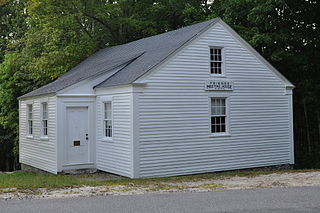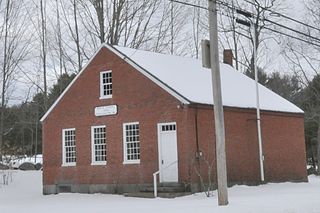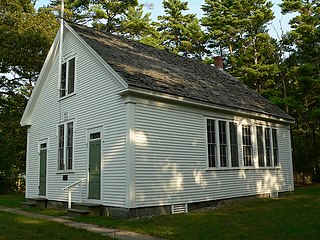
The Forestdale School, also known as the Greenville School, is a historic one-room school building at 87 Falmouth-Sandwich Road in Sandwich, Massachusetts. The single story wood frame structure was built in 1878, and is one of a small number of surviving district school buildings on Cape Cod. It has Greek Revival features, including gable end returns, and transom windows over the two entrances. The building was listed on the National Register of Historic Places in 1997.

Friends Meetinghouse is a historic Quaker meeting house on Quaker Ridge Road in Casco, Maine. Built in 1814, it is the oldest surviving Quaker meeting house in the state. It was listed on the National Register of Historic Places in 1975.

The District No. 5 School, also known as the Alfred Gore School, is an historic one room school at 781 Gore Road in Alfred, Maine. Built in 1872, it was used as a school until 1921, and was restored to its appearance of that time in the 2000s. It is the best-preserved of Alfred's surviving district school buildings, and was listed on the National Register of Historic Places on February 4, 2009.

The North School, also known locally as the Brick School, is a historic one-room schoolhouse at 63 Amesbury Street in Kensington, New Hampshire, United States. Built in 1842, it was the only brick schoolhouse built in the town, and is one of its four surviving 19th-century schools. Of those, it is the best-preserved, and is used as a local history museum. It served the town's educational purposes between 1842 and 1956, and is now a local history museum. The building was listed on the National Register of Historic Places in 2013.

The Fort Fairfield–Andover Border Crossing is an international border crossing between the towns of Fort Fairfield, Maine, United States, and Perth-Andover, New Brunswick, Canada on the Canada–US border, joining Maine State Route 161 and New Brunswick Route 190. The United States border station was built in 1933, and was listed on the National Register of Historic Places in 2014. The Canada border station was built in 2007, replacing the previous facility that was built in 1954. This crossing was a historical flashpoint during the bloodless Aroostook War of the 1830s, in which the US and Great Britain disputed the border's location. That dispute was ended with the Webster-Ashburton Treaty in 1842.

The District No. 9 Schoolhouse is a historic school building at 358 Hoyt Road in Gilford, New Hampshire. Built in 1815 and repeatedly altered to accommodated changing trends in school design, it is the best-preserved of Gilford's surviving district schoolhouses. Now a private summer residence, the building was listed on the National Register of Historic Places in 2000.

The Village School is an historic former schoolhouse at 69 School Street in Unity, Maine, USA. The building, which includes one storey and three rooms, was built in 1898 and was the largest grade school in Unity until 1953. The school which represents a transitional phase between district schools and fully consolidated district, was listed on the National Register of Historic Places in 2014.

Founders Hall is the oldest building standing on the campus of the Maine Central Institute, a private high school in Pittsfield, Maine. Built in 1868-77, it is an Italianate building of unusual architectural sophistication for rural Maine. The building was listed on the National Register of Historic Places in 1979. It is the centerpiece of the school's campus, housing classrooms, offices, and other facilities.

The Governor Brann School is a historic school building on United States Route 1 in Cyr Plantation, Maine. It presently is used by the plantation as a polling station and meeting place. The school was named for Louis J. Brann, who was Governor of Maine at the time of its construction in 1934. It is the best-preserved of the community's former district school buildings; it was listed on the National Register of Historic Places in 1993.

Weld Town Hall is located at 17 School Street in Weld, Maine. Built 1922-26 by the local Masonic Lodge, the build has been a major community center for many years, and has hosted its town meetings since 1925. It is now owned by the town, with space leased to the Masons on the second floor. It was listed on the National Register of Historic Places.

The Roosevelt School, now Hamlin Town Hall, is a historic former school building on United States Route 1A in Hamlin, Maine. Built in 1933, it is the best-preserved of two surviving district school buildings in the rural community. The building was listed on the National Register of Historic Places in 2007.

The Division No. 9 School is a historic former one-room schoolhouse on Maine State Route 9 in Wells, Maine. Built in 1900, it is the best-preserved of the town's surviving district school buildings, and is now a museum owned by the town. It was listed on the National Register of Historic Places in 1995.

Sunset Lodge is a historic summer lodge on the shore of Madawaska Lake in rural northern Aroostook County, Maine. It is a peeled log structure, built in 1932 by Bruce Ward, founder of Ward Cedar Log Homes, and early marketer of log structures for recreational and year-round living. The building was listed on the National Register of Historic Places in 1994.

Libby's Colonial Tea Room is a historic commercial building at 2713 Post Road in Wells, Maine. Built in 1922 as a restaurant, the building is now home to the Johnson Hall Museum, a privately run museum of Americana. The building, a rare survivor in the area of automobile-related tourist accommodations from the 1920s, was listed on the National Register of Historic Places in 2001.

Mallett Hall is a historic former hotel building at 2782 Lee Road in Lee, Maine. Built in 1889, it is a rare surviving example of a once-common form, a country hotel in rural Maine. Now owned by the local historical society, it serves as a community function space. It was listed on the National Register of Historic Places in 1993.

The Marsh School is an historic school at 930 Bangor Road in Prospect, Maine. Built about 1880, it is the only surviving one-room schoolhouse in the rural community, and also served for a time as its town hall. It was listed on the National Register of Historic Places in 2013.

The District No. 5 School House is a historic school building on Billings Road at School House Lane in Hermon, Maine. Probably built about 1880, it is the rural community's best-preserved one-room schoolhouse, and is now maintained by the local historical society. It was listed on the National Register of Historic Places in 1997.

The Southwest District School is a historic school building at 430 Simsbury Road in Bloomfield, Connecticut. Built in 1858, it is one of the town's few surviving 19th-century district school buildings. It was listed on the National Register of Historic Places in 1992.

33 Ledgelawn Avenue is an historic building in Bar Harbor, Maine, formerly St. Edward's Convent. It is an architecturally distinguished building designed by local architect Milton Stratton and built in 1917 in the Jacobethan style. The building was listed on the National Register of Historic Places in 1998. It was home to the Bar Harbor Historical Society until early 2019; it is now vacant and on the market.

A two-room schoolhouse is a larger version of the one-room schoolhouse, with many of the same characteristics, providing the facility for primary and secondary education in a small community or rural area. While providing the same function as a contemporary primary school or secondary school building, a small multi-room school house is more similar to a one-room schoolhouse, both being architecturally very simple structures. While once very common in rural areas of many countries, one and two-room schools have largely been replaced although some are still operating. Having a second classroom allowed for two teachers to operate at the school, serving a larger number of schoolchildren and/or more grade levels. Architecturally, they could be slightly more complex, but were still usually very simple. In some areas, a two-room school indicated the village or town was wealthier and more prosperous.
















